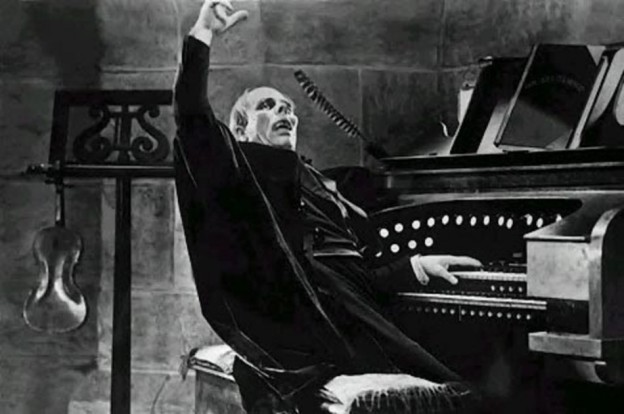
This is the last week of my spotlight on silent film essentials. I know, I’m sad too. But silent cinema will continue to be discussed here in one way or another. And the last film I’m writing about for this spotlight is one of the best. It’s The Man Who Laughs from 1928. Based on a novel by Victor Hugo and starring Conrad Veidt (the man who would later go on to be known for playing Maj. Strasser in Casablanca), it’s one of the best films of the silent era. Its main character also went on to inspire a comic book villain. More on that later. Let’s cut right to the chase and get you up to speed on the plot.
In England in 1690, the nobleman Lord Clancharlie (Conrad Veidt) returns from his exile to see his young son. The peer is captured by the cruel King James II (Sam De Grasse) and before being killed, he is informed that his beloved son had been sold to the gypsies Comanchicos that carved a permanent grin on his face. The Cormanchicos abandon the boy in the cold snowing winter, and while looking for shelter, he finds a baby hold in the arms of her dead mother. He brings the baby with him and they are welcomed by the philosopher Ursus (Cesare Gravina),who finds that the baby is blind and raises them. Years later, Gwynplaine becomes a successful clown, and together with the blind Dea (Mary Philbin), they present plays for common people. Gwynplaine (Conrad Veidt) and Dea are in love for each other, but he refuses to marry her because of his ridiculous appearance. When the evil jester Barkilphedro (Brandon Hurst) discloses the origin of Gwynplaine, he plots a means to be rewarded by the Queen (Josephine Crowell), jeopardizing the love of Gwynplaine and Dea. –IMDB
People familiar with Victor Hugo may notice the recurring theme of a character who is an outsider because of his physical ugliness. That was at the heart of his novel The Hunchback of Notre Dame. Also like Hunchback, The Man Who Laughs is about a character who survives with the help of strangers taking them in after being abandoned. So that’s the story. Now let’s talk about why this is a silent essential.
The Man Who Laughs is an essential because it’s one of the great examples of German expressionist film making. The film’s star, Conrad Veidt, was no stranger to German expressionism. He also starred in the silent expressionist horror classic The Cabinet of Dr. Caligari. Expressionism is a visual style that will be familiar to students of film noir: Dutch angle shots, venetian blind lighting, low ceilings, great visual use of shadows, etc. Noir came about in part because of film artists fleeing Nazi Germany and bring the style with them. That look works for something like The Man Who Laughs. On the surface is a period melodrama. But as it progresses it takes on the tone of a horror film. But I don’t want to turn this into a film noir history lesson. For that, see me after class.
This film is also a silent essential because of its star. Conrad Veidt appeared in over 100 films. But we lost him far too soon. As Roger Ebert notes in his Great Movies essay:
Veidt’s performance is far more than a stunt. Best known to modern audiences for his performance as the erect, unsmiling Maj. Strasser in “Casablanca,” he appeared in more than 100 films, including the German silent landmark “The Cabinet of Dr. Caligari.” He was one of a group of German refugees who might have made a great impact on Hollywood, had they lived. He was dead of a heart attack at 50, a year after “Casablanca.” Leni died at 44, a year after the release of “The Man Who Laughs,” and F.W. Murnau, director of “Nosferatu” and “Sunrise,” was dead in 1931, at 43.
Veidt wore a makeup device that distended his mouth while supplying grotesque teeth. It was horribly uncomfortable, making it even harder for him to project emotions only with his eyes. And yet there are scenes where we sense love, fear, pity and lust.
Like Lon Chaney’s performance in The Phantom of the Opera a few years earlier, Veidt’s performance was for more than an excuse to show off the work of the makeup department. His facial expressions tell a whole story on their own. This is what actors had to do in the days before sound and snappy dialogue. When you see The Man Who Laughs and then watch Casablanca, you realize what a loss it was that Conrad Veidt died so young. He was one of the most versatile actors of Hollywood’s Golden Age.
And now, let me tell you about that comic book connection I mentioned earlier. Conrad Veidt’s terrifying look inspired a Batman villain.
Gwynplaine’s fixed grin and disturbing clown-like appearance was a key inspiration for comic book talents writer Bill Finger and artists Bob Kane and Jerry Robinson in creating Batman’s greatest enemy, The Joker.–IMDB
Yes, a silent film from the 20s inspired arguable Batman’s greatest nemesis. The silent era’s influence goes well beyond movies. So there’s a fun piece of trivia to impress your friends with next trivia night.
The Man Who Laughs works as period melodrama, horror, and is one of the finest examples of the German expressionist visual style. It’s also a great showcase for the talent of Conrad Veidt, who many people know today only as the head Nazi in Casablanca (a part which he played with equal skill). It’s another silent essential I hope you’ll take the time to see.
That’s it for my spotlight on silent essentials. See you in June!


